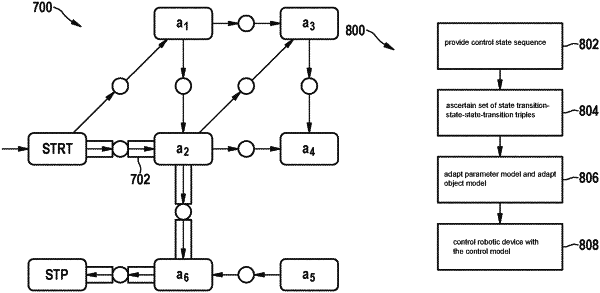| CPC B25J 9/163 (2013.01) [B25J 9/1653 (2013.01); B25J 9/1656 (2013.01); B25J 9/1661 (2013.01); B25J 9/1664 (2013.01); B25J 9/161 (2013.01); G06N 7/01 (2023.01)] | 10 Claims |

|
1. A method for controlling a robotic device, the method comprising the following steps:
training a control model, which includes a parameter model and an object model, the training including:
providing a control state sequence for each initial state-target state pair of a plurality of initial state-target state pairs, including states and state transitions from a set of possible states and state transitions, each initial state-target state pair including an initial state and a target state, the initial state indicating a state of the robotic device and one or multiple objects, the target state indicating a state of the robotic device and one or multiple objects, and each state transition being assigned a set of task parameters;
ascertaining a set of state transition-state-state transition triples, which are contained in the provided control state sequences;
for each state transition-state-state transition triple of the set of state transition-state-state transition triples:
adapting the parameter model for the state transition-state-state transition triple in such a way that the parameter model ascertains a probability distribution for each task parameter from the set of task parameters, which is assigned to the state transition following the state in response to an input of the state transition-state-state transition triple and of the assigned target state of the control state sequence, in which the state transition-state-state transition triple is contained,
adapting the object model for the state transition-state-state transition triple in such a way that the object model ascertains for each object of the one or multiple objects a probability distribution for the state of the object in response to an input of two state transitions of the state transition-state-state transition triple, to the respective states of the other objects of the one or multiple objects, to a set of task parameters, and of the assigned target state; and
controlling the robotic device with the control model starting from a predefined initial state via a sequence of states to a target state to be reached, a set of task parameters being ascertained in each state using the trained parameter model, a state transition to be executed being ascertained using the trained object model, and the robotic device being controlled to execute the state transition to be executed using the ascertained set of task parameters.
|